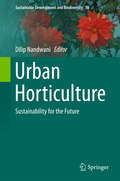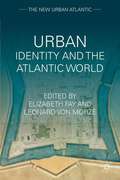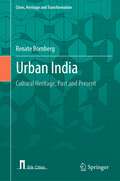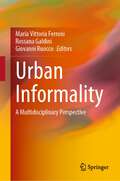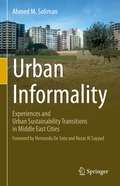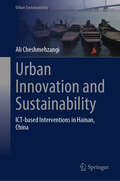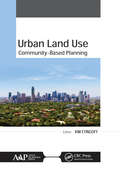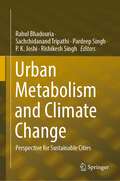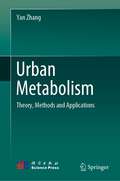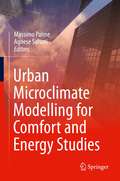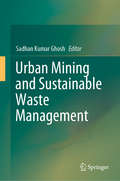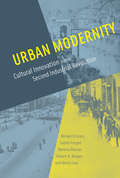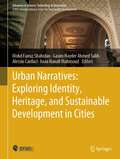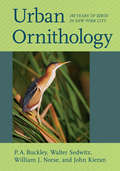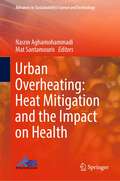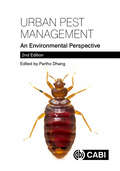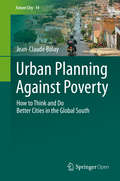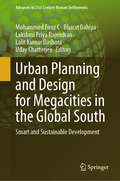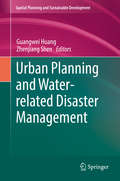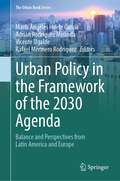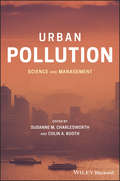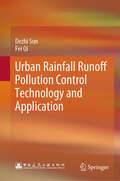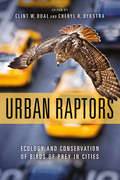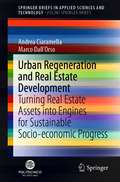- Table View
- List View
Urban Horticulture: Sustainability For The Future (Sustainable Development and Biodiversity #18)
by Dilip NandwaniThis book provides comprehensive information on the rapidly developing field of urban horticulture for sustainable use of land resources and creating a better environment. It presents peer-reviewed chapters from leading international researchers in the field of horticulture technologies, environmental issues, urban horticulture, and landscaping and its role in society. It covers a wide array of topics on this subject and constitutes a valuable reference guide for students, professors, researchers, builders, and agriculturists concerned with urban horticulture, city planning, biodiversity, and the sustainable development of horticultural resources. Urban horticultural technologies facilitate the efficient use of available land in urban and residential areas, helping meet the demand for fresh fruits and vegetables to feed ever-growing urban populations. The amount of green space in urban areas is dwindling due to rising land prices, while the climbing numbers of multi-story buildings are producing various environmental and health issues. Technological advances provide tools and techniques for high-density and vertical cropping in small areas, promoting efficient and sustainable resource utilization. As such, urban horticulture is gaining importance in city planning – not only to bolster the food supply but also to improve the aesthetic value, environmental conditions, landscape, and business environment, while also reducing the consumption of fossil fuel in transportation.
Urban Identity and the Atlantic World (The New Urban Atlantic)
by Elizabeth A. Fay Leonard Von MorzéThe constant flow of people, ideas, and commodities across the Atlantic propelled the development of a public sphere. Chapters explore the multiple ways in which a growing urban consciousness influenced national and international cultural and political intersections.
Urban India: Cultural Heritage, Past and Present (Cities, Heritage and Transformation)
by Renate BornbergThis book discusses the importance of socio-spatial patterns in cities that are embedded in the cultural heritage and self-understanding of a society, showing that Indian cities follow different urban concepts. In nine episodes (nine is a sacred figure), it highlights the principal influences and social impacts on cities from ancient times to contemporary city developments. As such, it provides planners and architects with insights that can easily be applied in contemporary cities and towns and help foster India’s cultural heritage—a much-needed, but little-discussed approach.Indian cities are the result of various factors, some imposed, others following local traditions that shaped them. They were founded around social needs, landscape conditions and production routines, as well as the religious influences of Hinduism, Buddhism, Jainism, Sikhism, Islam, Christianity and animism. However, Western town-planning models are often implemented, blurring the traditional way of life in cities. For sustainable town development, it is of key importance to find solutions that deal with Indian city models.
Urban Inequalities: A Multidimensional and International Perspective (The Urban Book Series)
by Graciela H. TononThis book proposes an interdisciplinary and multidimensional perspective of urban inequalities based on a range of theoretical, methodological, and professional approaches. Chapters consider different types of inequalities: in health, education, age, housing, energy, space, civic rights, social exclusion, ethnicity, poverty, segregation, work status, nutrition, public policies, democracy, human rights, technology, digital learning, subjective well-being, environment, and climate change. Contributions analyze the situation of different groups: children, youth, and indigenous people. The book highlights the importance of policy-making to overcome inequalities and addresses the key role of citizen participation.
Urban Informality: A Multidisciplinary Perspective
by Maria Vittoria Ferroni Rossana Galdini Giovanni RuoccoThis book analyzes the informal practices of contemporary cities through a close dialogue between different research perspectives, with the shared goal of giving voice to informality and evaluating its benefits and potential in a multidimensional key of social factors. Recently, the human sciences have seen the emergence of this new term “informality,” at first sight in conflict with their function of giving order and form to social phenomena. A term with which, in this book, the authors, having as reference the Italian and European experience, specifically identify those unsatisfied social demands and those collective actions “from below” that aim at the recovery of urban space and the renewal of its organization, often not following the trajectories of legality and institutions. By means of a close dialogue between different areas of social research, this book attempts to establish the different declinations and applications of the term, evaluating the causes and effects, benefits, and potential of the phenomena attributable to it, within a multidimensional analysis that calls into question the regeneration and collective use of spaces, political-institutional confrontation and conflict, legal innovation, and social-economic benefits.
Urban Informality: Experiences and Urban Sustainability Transitions in Middle East Cities
by Ahmed M. SolimanThis professional book introduces an analytical framework of urban informality perspectives in the Middle East that is aligned with the Global South. The context of Egypt, Lebanon, and Jordan—in the Middle East— is the transregional focus of this book. In these contexts, the book opens a new arena of academic discussion on the theory and practice of urban informality.Urban Informality: Experiences and Urban Sustainability Transitions in Middle East Cities questions urban informality, "as a site of transitions", interrelated and interlinked with urban sustainability transitions in speedy changes in a given environment. The book presents ‘urban informality sustainability transitions’ regarding resilience and adaptability that require shifts in urban systems. Shifts from a static process to a dynamic process that eradicates the fragmentation between the tensions, anxieties, and pressures of four modes of production, reproduction, consumptions, and distribution of goods and services in the city and its practices. Finally, through eleven chapters, the concluding remarks explore to what extent and how can urban informality transitions be sustainable.
Urban Innovation and Sustainability: ICT-based Interventions in Hainan, China (Urban Sustainability)
by Ali CheshmehzangiThis book is a collection of context-specific ICT-based interventions to achieve sustainability from various perspectives or dimensions. The book is based on case study examples in the strategic context of Hainan, South China. Five ICT-based pilot studies were conducted, surveyed, and analysed in 2021 and 2022. The studies explore impacts on four main sustainability dimensions of environmental, social, economic, and institutional. Several ICT-based interventions are suggested to enhance environmental protection, promote health and support in elderly communities, augment social media for place promotion, create online opportunities for local markets, and help boost local tourism industries. Urban Innovation and Sustainability is an attempt to highlight the positive side of ICT-based interventions in cities and communities. We also need to note the negative side of ICTs, which are partly covered in the case study examples. However, this book focuses on case study pilot examples to promote the nexus between innovation and sustainability. It is essential to explore opportunities that could later be scaled up, transform practices, and help develop context-specific policies. In essence, paradigm shifts, infrastructural development, and human-centric development are necessary. This book&’s findings interest scholars/researchers, practitioners, and authorities in various disciplines of urbanism, urban/human geography, urban studies, planning, innovation, and sustainability.
Urban Land Use: Community-Based Planning
by Kimberly EtingoffThis compendium volume, Urban Land Use: Community-Based Planning, covers a range of land use planning and community engagement issues. Part I explores the connections between land use decisions and consequences for urban residents, particularly in the areas of health and health equity. The chapters in Part II provide a closer look at community land use planning practice in several case studies. Part III offers several practical and innovative tools for integrating community decisions into land use planning.
Urban Metabolism and Climate Change: Perspective for Sustainable Cities
by P. K. Joshi Pardeep Singh Rishikesh Singh Rahul Bhadouria Sachchidanand TripathiThis book provides a basic understanding and state-of-the-art of urban metabolism. Urban centres are increasingly challenged by population increase and the resultant environmental concerns including the urban sprawl and climate change. Different patterns of urbanization contribute to the changing climate via. differences in their urban metabolism represented by energy and matter. Urban metabolic studies in terms of energy and material inflows, outflows, and stocks can be associated with traditional evaluation techniques to help assess the magnitude and potential effects of variety of environmental challenges the world is facing today. Urban centres are critical real time observatories that indicate the impact anthropogenic activities have on global biogeochemical cycles. Urban processes have significant and lasting impacts on the global carbon budget. The technological and infrastructural advancements have fuelled an increase in urban inputs and outputs of material and energy. Therefore, more sustainable approaches need to be adopted in changing scenarios for urban planning, particularly for sustainable resource utilization and better waste management practices. The book emphasises on the sustainability in urban metabolism, sustainable urban planning, ecosystem services, and disaster resilience to provide an interdisciplinary understanding of urban metabolism. The book also identifies an urgent need to develop new methodological approaches for real time and reliable evaluation of urban metabolism.
Urban Metabolism: Theory, Methods and Applications
by Yan ZhangThis book provides the basic theory, method framework and application results of urban metabolism. Urban metabolism is an important research philosophy and approach for analyzing urban mega organism and its ecological environmental problems. It has constantly formed quantitative network research framework and analysis methods in a metaphor way and expanded its application in different scales such as global, national, urban agglomeration and city to support the process of multi-scale regional sustainable development.
Urban Microclimate Modelling for Comfort and Energy Studies
by Massimo Palme Agnese SalvatiThis book discusses urban microclimate and heat-related risks in urban areas, brought on by the combination of global climate change effects and local modification of climate determined by extensive urbanization such as the ‘Urban heat island’ phenomenon. This matter is relevant to almost all urbanized areas in the world, where the increase of urban population and air temperature is expected to endanger both the overall health of the population and the energy supply for the functioning of urban systems. The book details the inter-relationship between urban morphology, microclimate and building energy performance and presents a multidisciplinary approach that brings together Urban Climatology, Engineering and Architectural knowledge to support the development of reliable models and tools for research and practice. This book is a useful tool for architects and building energy modelers, urban planners and geographers who need a practical guide to realize basic urban microclimate simulation for use in both academic research and planning practice.
Urban Mining and Sustainable Waste Management
by Sadhan Kumar GhoshThis book gathers selected high-quality research papers presented at the IconSWM 2018 conference, which explore various aspects of urban mining. In addition, they discuss how to achieve sustainable waste management systems, urban mining, landfill mining, material recovery, circular economy, etc., with the aid of effective waste management practices. Additional topics covered include maximum resource circulation and efficiency, key differences between landfill mining and urban mining, and how urban mining can be combined with the concepts of circular economy and sustainability.
Urban Modernity: Cultural Innovation in the Second Industrial Revolution (The\mit Press Ser.)
by Morris Low Miriam R. Levin Sophie Forgan Martina Hessler Robert H. KargonHow Paris, London, Chicago, Berlin, and Tokyo created modernity through science and technology by means of urban planning, international expositions, and museums.At the close of the nineteenth century, industrialization and urbanization marked the end of the traditional understanding of society as rooted in agriculture. Urban Modernity examines the construction of an urban-centered, industrial-based culture—an entirely new social reality based on science and technology. The authors show that this invention of modernity was brought about through the efforts of urban elites—businessmen, industrialists, and officials—to establish new science- and technology-related institutions. International expositions, museums, and other such institutions and projects helped stem the economic and social instability fueled by industrialization, projecting the past and the future as part of a steady continuum of scientific and technical progress. The authors examine the dynamic connecting urban planning, museums, educational institutions, and expositions in Paris, London, Chicago, Berlin, and Tokyo from 1870 to 1930. In Third Republic Paris, politicians, administrators, social scientists, architects, and engineers implemented the future city through a series of commissions, agencies, and organizations; in rapidly expanding London, cultures of science and technology were both rooted in and constitutive of urban culture; in Chicago after the Great Fire, Commercial Club members pursued civic ideals through scientific and technological change; in Berlin, industry, scientific institutes, and the popularization of science helped create a modern metropolis; and in Meiji-era Tokyo (Edo), modernization and Westernization went hand in hand.
Urban Narratives: Exploring Identity, Heritage, and Sustainable Development in Cities (Advances in Science, Technology & Innovation)
by Gasim Hayder Ahmed Salih Mohd Fairuz Shahidan Alessio Cardaci Israa Hanafi MahmoudThis book engages readers in an enlightening exploration of cities' identities, sustainability, and urban development. Delving into the intricate interplay between art, architecture, and the urban landscape, it offers a compelling analysis of the factors that shape cities and their distinct personalities. The volume uncovers captivating stories of cities as they navigate the delicate balance between heritage conservation and modernity. It highlights innovative strategies employed to preserve historical sites while adapting to the demands of a rapidly changing world. Full of insightful discussions on the impact of cultural lifestyles, the fusion of architectural styles, and the challenges and triumphs of sustainable urban development, it draws upon a diverse range of perspectives and research, inviting architects, urban planners, and scholars to delve into the intricate nuances of cities' identities in the process.With its informative and engaging narrative, this book providesa fresh perspective on cities' identities and offers practical insights into shaping vibrant, livable urban landscapes.
Urban Ornithology: 150 Years of Birds in New York City
by P. A. Buckley Walter Sedwitz William J. Norse John KieranUrban Ornithology is the first quantitative historical analysis of any New York City natural area’s birdlife and spans the century and a half from 1872 to 2016. Only Manhattan’s Central and Brooklyn’s Prospect Parks have preliminary species lists, not revised since 1967, and the last book examining the birdlife of the entire New York City area is now more than fifty years old.This book updates the avifaunas of those two parks, the Bronx, and other New York City boroughs. It treats the 301 bird species known to have occurred within its study area—Van Cortlandt Park and the adjacent Northwest Bronx—plus 70 potential additions. Its 123 breeding species are tracked from 1872 and supplemented by quantitative breeding bird censuses from 1937 to 2015. Gains and losses of breeding species are discussed in light of an expanding New York City inexorably extinguishing unique habitats.
Urban Overheating: Heat Mitigation and the Impact on Health (Advances in Sustainability Science and Technology)
by Mat Santamouris Nasrin AghamohammadiThe book reviews and reports the recent progress and knowledge on the specific impact of current and projected urban overheating as well as of the urban mitigation technologies on mortality and morbidity and urban vulnerability. It presents recent data and developments on the topic reported by some of the more distinguished researchers in this area. In parallel, it discusses new findings related to the characteristics and the magnitude of urban overheating and reports and analyzes the recent knowledge on the synergies between urban heat island and heatwaves. This book helps to advance our understanding on the interaction between Urban Heat Island (UHI) and overheating as well as their impact on energy demand and public health globally. Exploring the interaction between UHI and energy consumption requires the understanding on the dynamics of UHI intensity and air pollution index in different land use and how such interactions may vary in different cities in the world. Moreover, this book focuses on different cities in Australia, Austria, Belgium, Brazil, Canada, Cyprus, Greece, Hong Kong, India, Asia, Spain, UK, and USA.
Urban Pest Management: An Environmental Perspective
by Edited by Partho DhangThe management and control of pests in the urban environment in the 21st Century faces many challenges. Pest populations adapt to changing conditions brought about by environmental changes caused by global warming, human population growth, and increased pollution. Urban pests are able to expand their ranges, densities, and habitats, sometimes causing large-scale damage and disease. This book provides collective insights from academic and industry experts on perspectives concerning urban pest management and regulatory innovations arising from the rapid onset of recent environmental challenges. Chapter topics address pest biology, advances in urban pest management practices, emerging urban pest control developments, new technologies, and regulations. The book describes new methods of pest control, their impacts on human health and the environment, and strategies for integrated management limiting the use of chemicals. It provides a practical resource for researchers and policy makers in pest management, urban health, medical entomology and environmental science. This title provides: An up-to-date and comprehensive resource on environmental urban pest management. A resource designed to appeal to pest control operators, public health professionals, and a range of field workers, as well as researching academics and graduate students. Insights from both academic and industry experts together in one volume.
Urban Planning Against Poverty: How to Think and Do Better Cities in the Global South (Future City #14)
by Jean-Claude BolayThis open access book revisits the theoretical foundations of urban planning and the application of these concepts and methods in the context of Southern countries by examining several case studies from different regions of the world. For instance, the case of Koudougou, a medium-sized city in one of the poorest countries in the world, Burkina Faso, with a population of 115.000 inhabitants, allows us to understand concretely which and how these deficiencies are translated in an African urban context. In contrast, the case of Nueve de Julio, intermediate city of 50.000 dwellers in the pampa Argentina, addresses the new forms of spatial fragmentation and social exclusion linked with agro export and crisis of the international markets. Case studies are also included for cities in Asia and Latin America. Differences and similarities between cases allow us to foresee alternative models of urban planning better adapted to tackle poverty and find efficient ways for more inclusive cities in developing and emerging countries, interacting several dimensions linked with high rates of urbanization: territorial fragmentation; environmental contamination; social disparities and exclusion, informal economy and habitat, urban governance and democracy.
Urban Planning and Design for Megacities in the Global South: Smart and Sustainable Development (Advances in 21st Century Human Settlements)
by Bharat Dahiya Lakshmi Priya Rajendran Uday Chatterjee Mohammed Firoz C Lalit Kumar DashoraThis anthology, Urban Planning and Design for Megacities in the Global South: Smart and Sustainable Development, sheds light on the intricate dynamics of megacity growth in the Global South. It has compiled a rich and diverse array of evidence-based case studies, fostering discussions on emerging issues, strategies, and solutions for the enhanced planning and development of megacities in the Global South. By delving into the underlying factors propelling this rapid urban expansion, such as economic opportunities, rural-to-urban migration, and natural population growth, this volume analyzes the complex interplay of socio-economic, environmental, and political forces shaping city-regional landscapes. Examining the growth of megacities offers invaluable insights into the challenges and opportunities associated with urbanization in the 21st century. Furthermore, some cities that have not yet achieved megacity status have also been included in this book to provide a comprehensive understanding of urban growth dynamics and the related factors influencing this growth. By studying these rapidly expanding cities, their challenges in urban planning and policy implementation can be identified. These challenges often include inadequate infrastructure, insufficient public services, environmental degradation, and socio-economic disparities. In response, using case studies, the book presents conceptual and empirical strategies to tackle the various problems faced by megacities of the Global South.
Urban Planning and Water-related Disaster Management (Strategies for Sustainability)
by Zhenjiang Shen Guangwei HuangUrban areas face daunting environmental, economic and social challenges that have increased in scope in recent years, especially given climate change and globalization. At the same time, cities provide exciting opportunities for growth and revitalization of local and national economies. The interplay of these challenges and opportunities create important tasks for policymakers and researchers. This book provides a new horizon for exploring solutions to urban problems, especially water-related disasters in urban areas. It is of a cross-disciplinary nature offering both new concepts and practices that will help to promote communication between urban planning communities and water management professionals in order to integrate water-related disaster management into spatial planning.
Urban Policy in the Framework of the 2030 Agenda: Balance and Perspectives from Latin America and Europe (The Urban Book Series)
by María Ángeles Huete García Adrián Rodríguez Miranda Vicente Ugalde Rafael Merinero RodríguezThe book provides comparative information about the materialization of the 2030 Agenda in urban policy in ten countries located in Europe and Latin America. The Declaration of Quito is the starting point for the implementation of SDGs into public policies in urban areas. However, there are fewer efforts to understand the impact that the 2030 Agenda and, specifically, the instruments developed for its application in cities. The information of each country is presented in relation to two aspects: the construction of a public policy style in each country and the results and impacts on urban public policies implemented in specific cities within the national frameworks. The first means the emergence of a public policy framework and its materialization in public policy instruments. In this regard, the book raises the following questions: To what extent have the SDGs come to generate a common framework for cities in the countries? And how Urban SDGs are translated to national urban policies? The second, results and impacts at the local level, is related to two aspects: a) substantive: the goals of the policy and b) procedural: management aspects related to the policy design, governance, and institutional capacity building.
Urban Pollution: Science and Management
by Colin A. Booth Susanne M. CharlesworthMultidisciplinary treatment of the urgent issues surrounding urban pollution worldwide Written by some of the top experts on the subject in the world, this book presents the diverse, complex and current themes of the urban pollution debate across the built environment, urban development and management continuum. It uniquely combines the science of urban pollution with associated policy that seeks to control it, and includes a comprehensive collection of international case studies showing the status of the problem worldwide. Urban Pollution: Science and Management is a multifaceted collection of chapters that address the contemporary concomitant issues of increasing urban living and associated issues with contamination by offering solutions specifically for the built environment. It covers: the impacts of urban pollution; historical urban pollution; evolution of air quality policy and management in urban areas; ground gases in urban environments; bioaccessibility of trace elements in urban environments; urban wastewater collection, treatment, and disposal; living green roofs; light pollution; river ecology; greywater recycling and reuse; containment of pollution from urban waste disposal sites; bioremediation in urban pollution mitigation; air quality monitoring; urban pollution in China and India; urban planning in sub–Saharan Africa and more. Deals with both the science and the relevant policy and management issues Examines the main sources of urban pollution Covers both first-world and developing world urban pollution issues Integrates the latest scientific research with practical case studies Deals with both legacy and emerging pollutants and their effects The integration of physical and environmental sciences, combined with social, economic and political sciences and the use of case studies makes Urban Pollution: Science and Management an incredibly useful resource for policy experts, scientists, engineers and those interested in the subject.
Urban Rainfall Runoff Pollution Control Technology and Application
by Fei Qi Dezhi SunThis book comprehensively presents rapid progress and development in urban rainfall runoff pollution control technology in China since the 11th Five-Year Plan period. It covers many aspects of the research including background summary, assessment methods, control technology, and various case studies to the validation of the control theory and the development of sponge city construction. The book appeals to scholars and graduates majoring in environmental engineering and water supply engineering. It is also suitable for practitioners engaged in urban drainage system.
Urban Raptors: Ecology and Conservation of Birds of Prey in Cities
by Clint W. Boal Cheryl R. DykstraRaptors are an unusual success story of wildness thriving in the heart of our cities—they have developed substantial populations around the world in recent decades. But there are deeper issues around how these birds make their urban homes. New research provides insight into the role of raptors as vital members of the urban ecosystem and future opportunities for protection, management, and environmental education.A cutting-edge synthesis of over two decades of scientific research, Urban Raptors is the first book to offer a complete overview of urban ecosystems in the context of bird-of-prey ecology and conservation. This comprehensive volume examines urban environments, explains why some species adapt to urban areas but others do not, and introduces modern research tools to help in the study of urban raptors. It also delves into climate change adaptation, human-wildlife conflict, and the unique risks birds of prey face in urban areas before concluding with real-world wildlife management case studies and suggestions for future research and conservation efforts.Boal and Dykstra have compiled the go-to single source of information on urban birds of prey. Among researchers, urban green space planners, wildlife management agencies, birders, and informed citizens alike, Urban Raptors will foster a greater understanding of birds of prey and an increased willingness to accommodate them as important members, not intruders, of our cities.
Urban Regeneration and Real Estate Development: Turning Real Estate Assets into Engines for Sustainable Socio-economic Progress (SpringerBriefs in Applied Sciences and Technology)
by Andrea Ciaramella Marco Dall'OrsoThe book reflects on how intelligent urban regeneration can be an extraordinary driver of sustainable social and economic progress. It provides a friendly, evergreen and flexible thinking methodology that can serve as a reference guide to address a wide range of initiatives creating the conditions to thrive in an increasingly selective, rapidly changing and unpredictable market context. The book throws light on the importance of adopting an open approach based on collaboration, crafting strong visions, developing appealing value propositions, embracing a modern leadership style and setting-up highly effective multi-disciplinary team for the execution. It illustrates how standard approaches should be re-designed, business models innovated and processes re-engineered to guarantee better alignment between supply and demand of real estate as markets shift and new differentiators emerge among competitors. The book makes clear that creating a vibrant urban ecosystem requires a gradual shift of focus from built-environment investment to socio-economic output. It targets a wide audience of private and public sector professionals active in urban regeneration and real estate development.
